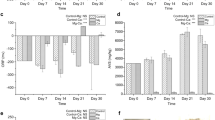Abstract
Denitrification potentials of epilithic microbial populations were assessed using the acetylene inhibition method, in which acetylene is used to block the reduction of nitrous oxide (N2O) to nitrogen (N2). Samples of the epilithic community were incubated in filtered river water containing modified Bushnell-Haas salts, glycerol, and yeast extract—under aerobic (0.2 atm O2) and anaerobic (0.2 atm He) acetylene atmospheres. N2O was produced under both atmospheres only if exogenous nitrate of nitrite was added. Denitrification potentials were typically higher when nitrite was the added electron acceptor. The rates of denitrification were temperature-and carbon-dependent and the maximum rate, 8.53 μg N2O−N per cm2 per day occurred at 23°C when nitrite was the electron acceptor.
Similar content being viewed by others
Literature Cited
Balderston, W. L., Sherr, B., Payne, W. J. 1976. Blockage by acetylene of nitrous oxide reduction inPseudomonas perfectomarinus. Applied and Environmental Microbiology31:504–508.
Bancroft, K., Grant, I. F., Alexander, M. 1979. Toxicity of NO2: Effect of nitrite on microbial activity in an acid soil. Applied and Environmental Microbiology38:940–944.
Brink, N., Widell, A. 1967. Eutrophication in a small stream in central Sweden. Schweizerische Zeitschrift für Hydrologie29:333–360.
Chan, Y.-K., Knowles, R. 1979. Measurement of denitrification in two freshwater sediments by an in situ acetylene inhibition method. Applied and Environmental Microbiology37:1067–1072.
Crutzen, P. 1976. Upper limits on atmospheric ozone reductions following increased application of fixed nitrogen to the soil. Geophysics Research Letters3:169–172.
Environmental Studies Board, United States National Research Council. 1978. Nitrates: An environmental assessment. Washington, D.C.: National Academy of Sciences.
Firestone, M. K., Firestone, R. B., Tiedje, J. M. 1980. Nitrous oxide from soil denitrification: Factors controlling its biological production. Science208:749–751.
Geesey, G. G., Richardson, W. T., Yeomans, H. G., Irvin, R. T., Costerton, J. W. 1977. Microscopic examination of natural sessile bacterial populations from an alpine stream. Canadian Journal of Microbiology23:1733–1736.
Greenberg, E. P., Becker, G. E. 1977. Nitrous oxide as end product of denitrification by strains of flourescent pseudomonads. Canadian Journal of Microbiology23:903–907.
Hart, L. T., Larson, A. D., McCleskey, C. S. 1965. Denitrification byCorynebacterium nephridii. Journal of Bacteriology89:1104–1108.
Hoare, R. A. 1979. Nitrate removal from streams draining experimental catchments. Progress in Water Technology11:303–314.
Kaushik, N. K., Robinson, J. B. 1976. Preliminary observations on nitrogen transport during summer in a small spring-fed Ontario stream. Hydrobiologica49:56–63.
Ladd, T. I., Costerton, J. W., Geesey, G. G. 1979. Determination of the heterotrophic activity of epilithic microbial populations. pp. 180–195. In: Costerton, J. W., Colwell, R. R., (eds.), Native aquatic bacteria: Enumeration, activity, and ecology. Philadelphia: American Society for Testing and Materials.
Meijer, E. M., van der Zwann, J. W., Wever, R., Stouthamer, A. H. 1979. Anaerobic respiration and energy conservation inParacoccus denitrificans. Functioning of iron-sulfur centers and the uncoupling effect of nitrite. European Journal of Biochemistry96:69–76.
Nakajima, T. 1979. Denitrification by the sessile microbial community of a polluted river. Hydrobiologia66:57–64.
Payne, W. J. 1973. Reduction of nitrogenous oxides by microorganisms. Bacteriological Reviews37:409–452.
Renner, E. D., Becker, G. E. 1970. Production of nitric oxide and nitrous oxide during denitrification byCorynebacterium nephridii. Journal of Bacteriology101:821–826.
Riemer, M., Harremoes, P. 1978. Multi-component diffusion in denitrifying biofilms. Progress in Water Technology10:149–165.
Rowe, J. J., Yarbrough, J. M., Rake, J. B., Eagon, R. G. 1979. Nitrite inhibition of aerobic bacteria. Current Microbiology2:51–54.
Sanders, W. M. 1966. Oxygen utilization by slime organisms in continuous culture. Air and Water Pollution International Journal10:253–276.
Smith, M. S., Firestone, M. K., Tiedje, J. M. 1978. The acetylene inhibition method for short-term measurement of soil denitrification and its evaluation using nitrogen-13. Soil Science Society of America Journal42:611–615.
Sørensen, J. 1978. Capacity for denitrification and reduction of nitrate to ammonia in a coastal marine sediment. Applied and Enviromental Microbiology35:301–305.
Sørensen, J. 1978. Denitrification rates in a marine sediment as measured by the acetylene inhibition technique. Applied and Environmental Microbiology36:139–143.
Tomlinson, T. G., Snaddon, D. H. M. 1966. Biological oxidation of sewage by films of microorganisms. Air and Water Pollution International Journal10:865–881.
Van Kessel, J. F. 1977. Removal of nitrate from effuent following discharge of surface water. Water Research11:533–537.
Ventullo, R. M., Ladd, T. I., Costerton, J. W., Rowe, J. J. 1981. Metabolic activity of epilithic bacterial populations of lotic environments. Abstracts of the 44th Annual Meeting of the American Society of Limnology and Oceanography1981:73.
Williams, D. R., Rowe, J. J., Romero, P., Eagon, R. G. 1978. DenitrifyingPseudomonas aerugionsa: Some parameters of growth and active transport. Applied and Environmental Microbiology36:257–263.
Yoshinari, T., Hynes, R., Knowles, R. 1977. Acetylene inhibition of nitrous oxide reduction and measurement of denitrification and nitrogen fixation in soil. Soil Biology and Biochemistry9:177–183.
Yoshinari, T., Knowles, R. 1976. Acetylene inhibition of nitrous oxide reduction by denitrifying bacteria. Biochemical and Biophysical Research Communications69:705–710.
Author information
Authors and Affiliations
Rights and permissions
About this article
Cite this article
Ventullo, R.M., Rowe, J.J. Denitrification potential of epilithic communities in a lotic environment. Current Microbiology 7, 29–33 (1982). https://doi.org/10.1007/BF01570976
Issue Date:
DOI: https://doi.org/10.1007/BF01570976




